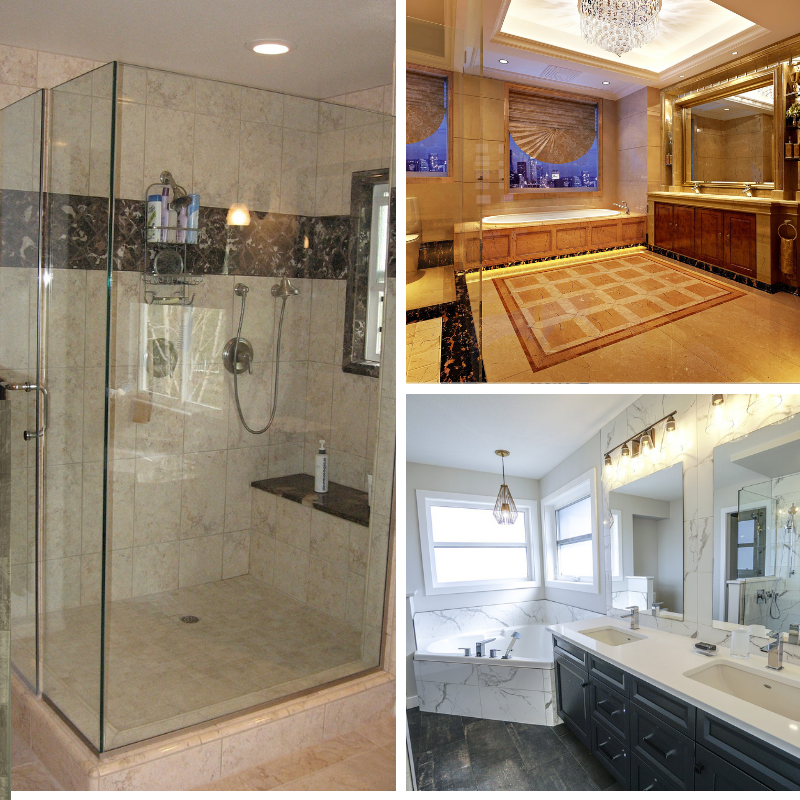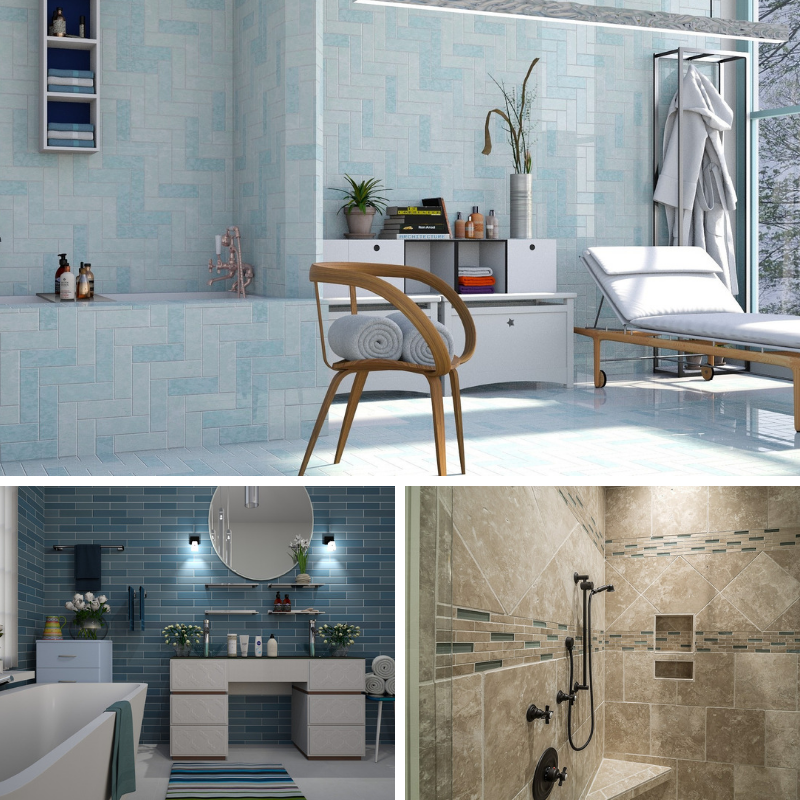Bathroom Wall Blues: Choosing Between Marble and Ceramic Tiles
Bathroom Walls: Finding Which Material Suits You Best
Most people won’t think much of their bathroom when it comes to renovation. To some, it’s a place where they take a bath and go. But no, your bathroom is more than that. The bathroom is one of the places you spend the most time in your home.
Don’t believe it? According to Infographics Archive, the average person spends more than 2 years of their lifetime in the bathroom. To be exact, men spend 2 years 125 days in the bathroom, whereas women spend 2 years 40 days. Of the time spent, men spend on average 185.4 days showering, and women spend 195.7 days instead.
Therefore, your bathroom is “not just another place” in your home. Infographics Archive have made a infographics below to summarise the average amount of time people spend in the bathroom. We have certainly spent a lot of time in our bathrooms!

If you are to spend so much time in the bathroom, you may as well make time spent in it worthwhile. Make your bathroom look pretty and spectacular. Wow your guests who visits you during gatherings. Sweep your relatives off their feet with the impressive walls.
Walls. One of the first things people will lay eyes on upon entering your bathroom. Utilize it by giving it a striking appearance. By doing so, some of the most commonly used materials for bathroom walls are marble and tiles.
Both marble and tiles have their own uses, but differ as night and day. Depending on your budget and tastes, read on to find out what fits your bathroom best!
Marble Walls: Luxury Living in the Bathroom
The pros: Why you’d love to have marble walls in the bathroom

Aesthetically pleasing.
There are no contests that marble anything instantly gives the space a royal feel. Bathroom walls made of marble makes it modern, yet classical. It exudes luxury and rids gloominess in your bathroom. Incorporating marble walls in your bathroom makes its space appear bigger than it really is. It also makes your bathroom look like one of those out of a high-end hotel!
Easy to work with. Marble is a soft stone that can be milled, machined and tumbled. It means marble can have multiple uses.
Durable.
Marble is durable as it is a high density stone, and can last for ages. It is also heat-resistant. So if you are to have a hot shower, it is less likely the marble wall will crack under long-term heat exposure.
Eco-friendly.
As marble is formed from natural limestone, it is completely degradable by end of its life time. You do not need to dispose old marbles as you can reuse them for something else. This makes marble recyclable and environmentally friendly.
The Cons: The Ugly Side of Marble You Don’t Want to See
Marble walls in the bathroom may be aesthetically pleasing and all, but think practicality. You are using marble in the bathroom, so there are bound to be some drawbacks to take into consideration.
Stain prone.
As marble contains minerals, there are risks its iron contents will turn to rust in a bathroom. What was supposed to be an elegant installation can be ruined when the iron element discolours from humidity and moisture.
Perform a soak test on your marble choice to see if it works in your bathroom. All you need to do is to put your marble tile choice into a bucket of water for two days. After that, take it out and let it sit for two more days. Observe any changes it made carefully.
Risky reparations.
Imagine if you accidentally break your marble wall. If you installed marble tiles, it’s easier to replace just the one tile. It will not look good as the replaced tile stands out like a sore thumb. If there is anything you should know about marble tiles, is that the same batch of tiles are made from the same marble mined. Oftentimes, when homeowners want to peruse marble tiles as their wall or flooring material, they are often advised to buy an extra batch.
Now imagine if it’s a marble slab you installed as a wall. Any damages incurred, you will have to replace the entire wall. Replacements can get expensive even at times.
Maintenance.
Marble is one of the materials that require a solid amount of maintenance. Oftentimes, people who opt for marble walls are advised to seal it with quality sealers and maintain it on a regular basis. You will have to avoid using strong cleansers to prevent etching or damages to the sealer. You should never use acidic cleansers on marble as it will leave an ugly mark on it.
Marble, regardless of where you use it, is made “to be seen but not used” as claimed by one user who has used it in its bathroom. The user has documented its “bathroom marble adventures” in two parts, namely here and here. It has gone on to make a post why it is not a good idea to use it in your bathroom.
Ceramic Tiles: Every man’s go-to choice
For more practicality and affordability, renovators would often homeowners to opt for tiles over marble. To be more precise, renovators would propose ceramic tiles.
Here are several reasons why you should or should not choose tile for your bathroom.

The Advantages: Why Choose Ceramic Tiles
Budget-friendly.
Remember not everyone is rich enough to afford marble walls, so ceramic and porcelain tiles would be one of their top choices for affordability. Ceramic and porcelain tiles come in a variety of price range, meaning to say there is something for every budget level. Its material is also versatile as it is not just fitting for bathroom walls, but also for floors and ceilings. In other words, tiles can be used on just about anywhere in the house.
Durability.
Like its marble counterpart, it is also durable. It can stand the wear and tear from test of time. With the right grout and regular care, ceramic and porcelain tiles are fairly low maintenance. Let’s say if you did break a tile, it’s fairly easy to replace the tile as long as there is stock for its kind.
Water resistant.
Glazed ceramic tiles have hard and protective layers that make the tiles impervious to water and most stains. This makes them naturally resistant to high humidity environments. This is the main reason as to why ceramic tiles are preferred and frequently used in wet areas like bathrooms, kitchens and whatnot.
The Disadvantages: Not So Graceful
Permanence.
While ceramic tiles may have been very durable, it is its own weakness also. The drawback in ceramic tile is its design. It is not as timeless as its marble counterpart, and may go out of style after a period of time. Let’s say you got really tired of the look emanating from your tile walls and want to change it. You will face a messy and costly renovation project to have its removal and replacement.
Grout lines are an issue.
Ceramic may be fairly easy to maintain, but its grout lines are an issue. Grout lines are susceptible to stains, mold and mildew and have to be periodically sealed to maintain its integrity. Since ceramic tiles are often used in wet areas, it requires caulking. Caulking needs to be replaced periodically, especially when it no longer seals the seam as a result of aging or cracking.
Easy to break.
Ceramic may be a hard material, but has a downside to it. It may break upon really hard impact against a ceramic-tiled wall as it has no flexibility. If it were to break, that means you will have to take time to find replacement tiles where sometimes may not match your existing colours. It’s a give-and-take situation.
Which to Choose?
Marble walls have been increasingly popular among people in the last years as it is pleasing to the eye. It has the wow-factor people have been looking for, as it is now made easily available in the market. The natural quality of the stones coupled with its beauty have been widely popular in the markets.
Articles that may interest you:
Marble Walls: How to make it work
Marble feature wall ideas
The definitive kitchen guide

